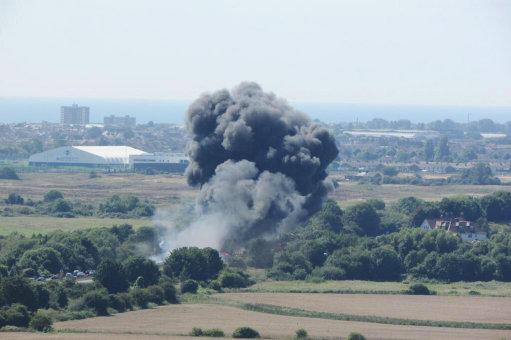Report: “Pilot errors led to Shoreham air crash”
Pilot errors and ineffective measures to protect the public led to the deaths of 11 people, after a vintage jet crashed on to a dual carriageway at the Shoreham Airshow, during a rolling manoeuvre.

Former RAF pilot Andy Hill, who survived the crash, is said to have carried out the manoeuvre at less than maximum thrust.
On publication of the report into the disaster, AAIB principal inspector Julian Firth said: “The aircraft crashed because at the top of its aerobatic manoeuvre it was too low to complete it.”
It would have been possible to abort it safely at the apex of the loop but Mr Hill had not been trained in the escape manoeuvre which might have got him out of trouble, the report says.
Training and assessment procedures in place at the time of the accident did not prepare the pilot fully for the conduct of relevant escape manoeuvres in the Hunter.
The AAIB also found the severity of the outcome of the crash was due to “an absence of provisions to mitigate the effects of an aircraft crashing in an area outside the control of the organisers of the flying display”.
The report said the risk assessment “was not suitable and sufficient to manage the risks to the public”, and the Civil Aviation Authority (CAA) did not require to see or approve risk assessments before issuing a permission to hold a flying display.
Previous articles on the Shoreham Airshow crash:
Shoreham air crash pilot investigated for manslaughter
- The aircraft did not achieve sufficient height at the apex of the accident manoeuvre to complete it before impacting the ground because the combination of low entry speed and low engine thrust in the upward half of the manoeuvre was insufficient.
- An escape manoeuvre was not carried out, despite the aircraft not achieving the required minimum apex height.
The following contributory factors were identified:
- The pilot either did not perceive that an escape manoeuvre was necessary, or did not realise that one was possible at the speed achieved at the apex of the manoeuvre.
- The pilot had not received formal training to escape from the accident manoeuvre in a Hunter and had not had his competence to do so assessed.
- The pilot had not practised the technique for escaping from the accident manoeuvre in a Hunter, and did not know the minimum speed from which an escape manoeuvre could be carried out successfully.
- A change of ground track during the manoeuvre positioned the aircraft further east than planned producing an exit track along the A27 dual carriageway.
- The manoeuvre took place above an area occupied by the public over which the organisers of the flying display had no control.
- The severity of the outcome was due to the absence of provisions to mitigate the effects of an aircraft crashing in an area outside the control of the organisers of the flying display.
To read the full report and to watch an animation to visualise the aircraft’s final manoeuvre click here.
Report: “Pilot errors led to Shoreham air crash”
Pilot errors and ineffective measures to protect the public led to the deaths of 11 people, after a vintage jet
Lauren Applebey
SHP - Health and Safety News, Legislation, PPE, CPD and Resources Related Topics
SHP’s top 10 health and safety prosecutions of 2023
‘More supportive working cultures are needed’ to reduce employee absence – which is at the highest rate in more than a decade
ESG consultants key spend for sector, survey reveals

